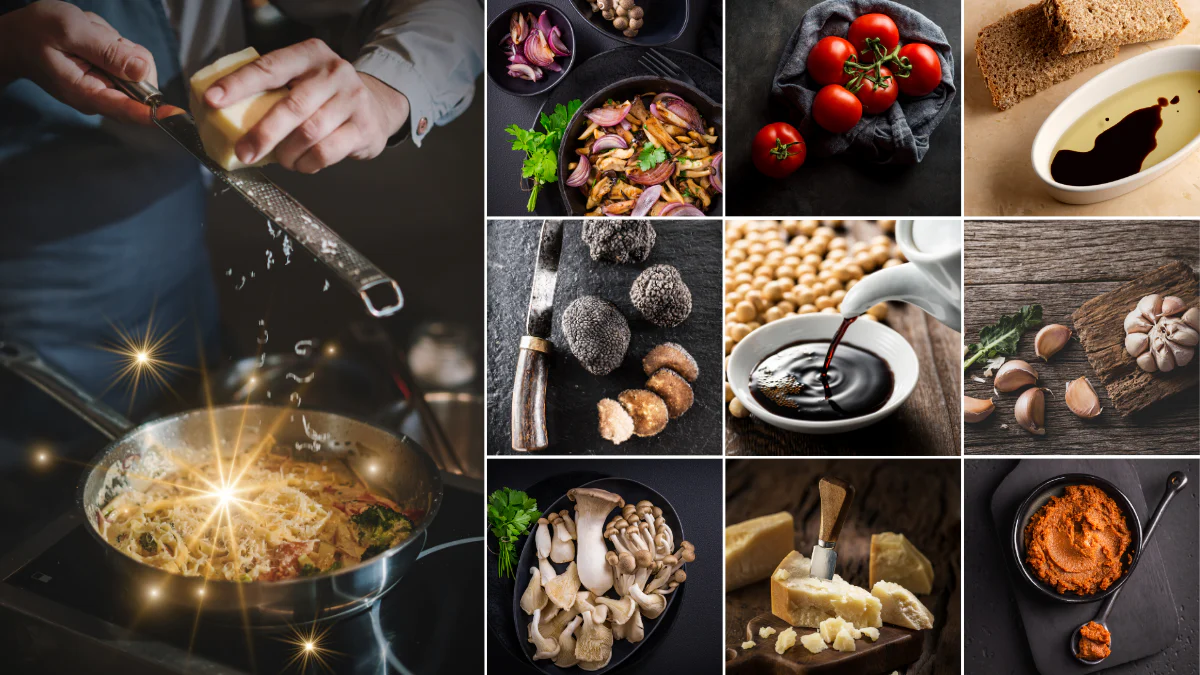Ask any expert and they will tell you there are five basic flavors. More specifically, they might mention umami – the satisfying umami taste that’s so popular today.
Umami can be found in many everyday kitchen ingredients and techniques such as soy sauce and miso fermentation to Parmesan cheese and cured meats – cooking techniques such as reducing, roasting and boiling can enhance these flavors to bring out their full umami potential.
Meats
Umami, or umami aroma and flavor, can add another dimension to food, providing it with an almost intangible savory essence that complements other ingredients. You’ll find this unique savory taste in dry aged or cured meats such as duck, chicken, beef or seafood rich in free glutamic acid such as anchovies, squid or clams; while other great sources are Parmesan cheese, dried mushrooms, tomatoes or eggs.
Umami can be increased through various cooking techniques that alter protein and carb structures. Drying or curing increase umami, as does slow cooking and fermentation – for instance adding soy sauce, miso or fermented fish sauce can add it. Furthermore, Maillard reactions caramelize proteins and sugars, further adding umami to foods.
Seafood
Umami can be found in various forms of seafood, from bony fish like cod and salmon through more primitive sharks, rays, sawfish and sturgeon; to crustaceans such as lobsters, shrimp and crabs as well as cephalopod mollusks like clams oysters periwinkles and mussels.
Kikunae Ikeda, the Japanese chemist who discovered umami in 1908, identified its flavor while studying seaweed broth made with Kombu seaweed. After isolating its source molecule – glutamate – he coined the term umami (“deliciousness”) to describe it. Ikeda later created a process to synthesize glutamic acid for use as an additive known today as monosodium glutamate (MSG), widely used to enhance umami flavor enhancement in soups, sauces and stews to boost umami flavor intensity.
Vegetables
Vegetables that have reached full ripeness have an inherently rich umami flavor, as as they ripen their glutamate levels increase and free glutamate concentrations rise.
Food preparation and caramelization can unlock umami. The Maillard reaction, a chemical process which creates complex flavors in meat and vegetables by mixing sugars with proteins, also unlocks umami.
Fish sauce, soy sauce and vegetable broth enhance their umami (savory taste) exponentially, adding depth of flavor. You can use these in dishes featuring different vegetables like ginger miso eggplant or butternut squash shiitake ragout. Dried mushrooms and seaweed also offer ample umami; try rehydrating them in water before adding to soups or stews, or making your own vegetable bouillon to use as part of sauces and broths. The liquid that remains from these absorbent ingredients is excellent for creating sauces and broths from them (using chicken bouillon in place of chicken). Soaked mushrooms and seaweed make excellent sources of umami; try adding them as ingredients that enhance flavour without alteration – try ginger miso eggplant or butternut squash shiitake ragout as part of dishes made up by various vegetable combinations like ginger miso eggplant or butternut squash shiitake ragout made up by adding ingredients such as ginger miso eggplant or butternut squash shiitake ragout! Dried mushrooms and seaweed are good sources of umami; they can also make delicious additions by rehydrating them, and by replacing chicken broth with vegetable bouillon created this way can even create homemade vegetable-infused vegetable-powered broth/boillon/bean and soak liquid when making sauces/broths/ soaking liquid from dried mushroom/ seaweed/ seaweed to soups/ stews/ stews/ broth/etc!
Cheeses
Addition of Parmesan cheese elevates any dish, but particularly soups and sauces. Furthermore, the Maillard reaction – when meats and vegetables are cooked at high temperatures together – contributes umami flavoring.
One key ingredient is Japanese dashi broth, made by simmering dried fish, kelp and dried shiitake mushrooms together with dried mushrooms, tomatoes, anchovies miso paste soy sauce and Worcestershire sauce for umami-rich flavoring.
Umami-rich ingredients such as yeast and porcini mushroom powder are great ways to add rich umami flavors. Both can be added to soups, sauces and stocks; both also work wonderfully as dry rubs for grilling or roasting meats. There are also umami powder blends which combine glutamates, inosinates or guanylates which complement each other for richer flavors, which you can find at both Trader Joe’s and Simply Organic.
Spices
To fully enjoy savory flavors, we must balance them with salty elements such as sauces or stews. For instance, adding umami will increase savory without increasing sodium intake.
Synergy is an integral aspect of flavor chemistry. To maximize umami, chefs combine foods high in glutamate (such as mushrooms) with foods rich in inosinate or guanylate – like meat or cheese – that have inosinate or guanylate properties to create more intense flavors than either ingredient would on its own. Roasting tomatoes before caramelizing or simmering a soup containing kombu can also unlock their umami potential.








